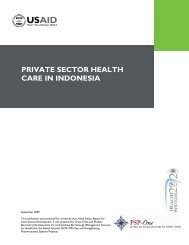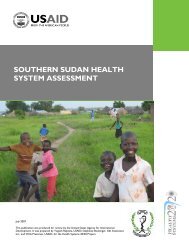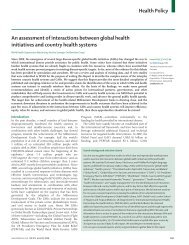Case Study on Piloting Complex Health Reforms in ... - PHRplus
Case Study on Piloting Complex Health Reforms in ... - PHRplus
Case Study on Piloting Complex Health Reforms in ... - PHRplus
You also want an ePaper? Increase the reach of your titles
YUMPU automatically turns print PDFs into web optimized ePapers that Google loves.
8. C<strong>on</strong>clusi<strong>on</strong>s<br />
Despite the absence of a rigorous comprehensive evaluati<strong>on</strong>, the health reform pilot <strong>in</strong> Issyk-Kul<br />
oblast can be c<strong>on</strong>sidered a success. It was rolled out nati<strong>on</strong>ally and <strong>in</strong>formed nati<strong>on</strong>al level health<br />
reforms. While each of the factors described above is important <strong>in</strong> itself, perhaps the greatest<br />
achievement of the health reforms <strong>in</strong> Kyrgyzstan was the creati<strong>on</strong> of a dynamic <strong>in</strong>teracti<strong>on</strong> and<br />
iterati<strong>on</strong> am<strong>on</strong>g the factors, coord<strong>in</strong>ated by health champi<strong>on</strong>s and d<strong>on</strong>ors guided by a unified health<br />
reform visi<strong>on</strong>. A mechanism that enabled susta<strong>in</strong>able health system improvements at the facility,<br />
oblast, and nati<strong>on</strong>al levels was the end result of the pilot rather than the effectiveness of the pilot itself<br />
or its successful roll-out.<br />
Creat<strong>in</strong>g a dynamic for system- and facility-level change happened <strong>in</strong> three stages. The first stage<br />
was the <strong>in</strong>itial pilot process that developed the <strong>in</strong>ternal work<strong>in</strong>gs or “eng<strong>in</strong>e” of the health reform<br />
process and addressed the technical issues at the core of the system – health delivery system<br />
restructur<strong>in</strong>g, populati<strong>on</strong> <strong>in</strong>volvement, provider payment systems, and health <strong>in</strong>formati<strong>on</strong> systems.<br />
This process was started <strong>in</strong> Issyk-Kul oblast but was later rolled out to Bishkek and Chui oblast, then<br />
to South Kyrgyzstan, and then nati<strong>on</strong>wide.<br />
The sec<strong>on</strong>d stage united these technical comp<strong>on</strong>ents under a unify<strong>in</strong>g visi<strong>on</strong> (the s<strong>in</strong>gle-payer<br />
system) and repackaged the system to resp<strong>on</strong>d to c<strong>on</strong>sumers and patients (the benefits package) –<br />
add<strong>in</strong>g a “chassis” to the health reform eng<strong>in</strong>e. The system-level reforms also created the aut<strong>on</strong>omy<br />
and “space” needed to move forward with facility-level quality improvements. In the first stage, many<br />
attempts at facility improvements had proved unsuccessful or unsusta<strong>in</strong>able due to system-level<br />
barriers and obstacles to implementati<strong>on</strong> and regulati<strong>on</strong>. The s<strong>in</strong>gle-payer system was piloted <strong>in</strong><br />
Issyk-Kul and Chui oblasts, then rolled out each year <strong>in</strong> two oblasts at a time.<br />
Kyrgyzstan recently entered a third stage <strong>in</strong> the health reform process where a dynamic for<br />
susta<strong>in</strong>able change has been created – opportunities for both system-level and facility-level<br />
improvements exist. The MOH c<strong>on</strong>t<strong>in</strong>ues to design, implement, and evaluate pilot health reform<br />
<strong>in</strong>terventi<strong>on</strong>s <strong>in</strong> Issyk-Kul oblast (and other oblasts), and immediately c<strong>on</strong>nects these efforts to<br />
nati<strong>on</strong>al health reforms. Simultaneously, implementati<strong>on</strong> of facility-level <strong>in</strong>terventi<strong>on</strong>s c<strong>on</strong>t<strong>in</strong>ues to<br />
reveal problems with medical practices and standards, medical educati<strong>on</strong>, and public health that <strong>on</strong>ly<br />
the health system can address. The development of an effective dynamic process and experienced<br />
health reformers that allow and encourage susta<strong>in</strong>able health system improvements at both facility<br />
and system levels is the best legacy of the Issyk-Kul oblast pilot, and may be the true measure of its<br />
success.<br />
8. C<strong>on</strong>clusi<strong>on</strong>s 33

















